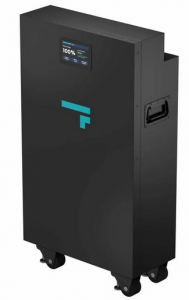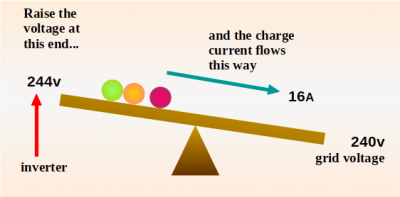Increasing Demand on my Electricity Supply
I obtained G99 approval for my PV and Battery installation last year. I have an 80A fuse fitted and approved Maximum Import Capacity of 18.4kVA (“fixed for 12 months”). I noticed at the weekend when I had my EV on charge (scheduled by Intelligent Octopus Go) that my battery also took advantage of the low-rate tariff, resulting in a grid load somewhat over 13kW. Consider ‘laundry day’, cooking and my plans for an ASHP and it’s easy to see that I could go over my limit without some careful management (my Zappi charger already has a facility to limit grid demand built-in; the inverter possibly not).
NGED’s policy is now to restrict single phase domestic supplies to 80A maximum. I know you are a proponent of 3-phase supplies for domestic properties but even if my DNO (NGED) were to provide an upgrade F.O.C., there would still be significant disruption and inconvenience to balance the load across the phases. Although costly, the domestic consumer unit replacement would be relatively easy: kitchen on one phase, remainder of downstairs (plus garage, etc.) on phase 2 and upstairs on phase 3. My PV installation uses microinverters, so could easily be split across phases, if considered worthwhile (obviously, they’re generators rather than loads, but they can still unbalance the grid). Unfortunately, I seem to have painted myself into a corner with my Givenergy All-In-One battery, as it’s a single-phase item. I had been considering acquiring extended battery capacity to accompany my proposed ASHP and a second All-In-One was my immediate choice. Having 2 single phase AIOs and (perhaps) a 3-phase ASHP would seem a bit pointless and I would no longer have any power-cut protection. I think I’ll just have to do my best to manage my grid demand and cross my fingers hoping that I don’t upset the local grid neutral. What would you do?
When our battery is charging at 10 kW and the DHW is also taking 3 kW, the heat pump is taking 2 kW whilst the house ‘background load’ may be up to a further kW, we are totting up a 16 kW (or slightly more!) load to a single phase of the grid. I don’t know the main fuse rating though 🤨. Must be close to limit I feel. Regards, Toodles.
Toodles, heats his home with cold draughts and cooks food with magnets.
@toodles I wouldn't worry unduly about exceeding the supply fuse rating occasionally, although I suspect it could affect the 'life' of the fuse eventually. I'm more concerned about contributing to the risk of unbalancing the 3-phase supply at my neighbourhood sub-station.
@ianmk13 Hence my mentioning of ‘single phase’; I understand about phase imbalance and I have no idea if my local substation is monitored in such a way that the balance is known or not by those who need to know. As far as I can tell, there are very few roofs adorned with PV panels in this area, there are very few heat pumps visible or known of either. I think there may be a few EV’s in the area but again, not many to my knowledge. Regards, Toodles.
Toodles, heats his home with cold draughts and cooks food with magnets.
@toodles If you were to be making an LCT application today (which you're not), your Total Household Demand would need to be calculated.
If that were found to be around 16kW, then your home is a borderline case for being moved to 3-phase.
The guideline figure most commonly used by DNOs is 60A current demand from a single-phase.
But there are many variables involved in the calculation:
- the size of the 3-phase cable "in the road" from which your house is supplied
- the cable length between you and the local substation transformer
- the number of houses between you and the transformer which are supplied from the same phase as you
- the 'available demand capacity' of the substation
- the total export to that substation from other houses which have solar/wind generation
- the number of houses on that substation feed with heat-pumps and/or EV chargers
I have access to that data for substations in the four regions for which NGED is the DNO.
But I don't have the algorithm which is then applied, so I still couldn't arrive at the same answer as the Network Planner for the area.
In the case of @ianmk13 (who doesn't live in post-code MK13, in case you wondered!) I did previously supply him with substation data (Nov'23), prior to the installation of his GivEnergy All-in-One storage battery.
There have obviously been changes to the loading of his substation since then, and I'm happy to share some of the current details with forum members by way of illustration:
- Transformer size: 500kVA with four 'Feeds' at 440v
- Daytime max. demand: 237kVA
- Night-time max. demand: 519kVA (3.8% overload)
- Connected properties: 269
- EV chargers: 25 (assumed to be 7½kW each)
- Heat pumps: 3
- Solar generation: 31 properties, contributing a total of 136kW (which is why daytime demand is lower)
- Storage batteries: 5 properties
Ian's location on the Feed which supplies him from that substation is significant, but I'm withholding that level of detail.
Ian - you are right to observe that the GivEnergy AIO inverter is the sticking point should you wish to (or need to) have a 3ph connection for a heat-pump.
But I don't know what version of the AIO kit you have, so I'm loathe to make any suggestion at this stage.
Save energy... recycle electrons!
Thank you for that information @transparent, my G99 application for 8.96kWp. was processed (took some 12 weeks) without a query and I have not personally dealt with them since. The ASHP was installed later and any contact with my DNO was handled by the installer if it was required. I am very unlikely to be requesting an EV charging facility so I suppose I just leave well alone - though it would be nice to know if the phases are being treated nicely locally! Regards, Toodles.
Toodles, heats his home with cold draughts and cooks food with magnets.
Posted by: @transparentIn the case of @ianmk13 (who doesn't live in post-code MK13, in case you wondered!)
You're giving my secrets away! I'd wager that it's more than likely that you're not as transparent as your moniker would suggest. 😉
My AIO is a 13.5kWh model with a gateway. If I remember correctly, the recently-announced version is also a single-phase unit.
I'm not aware of there having been any supply failures on my substation, but I frequently hear of faults within a mile or two. I would like to 'do the right thing' but I feel that I am between a rock and a hard place. It would have been preferable had I been aware of a 3-phase upgrade option before I spent £14k last year and I could have given it some thought then. I am not too averse to my equipment being controlled by a third party: my car and battery charging benefit from the Octopus IOG tariff, but I expect that charging slots are based solely on half-hourly wholesale prices, with no consideration of grid loads. Notwithstanding the potential risk of 'bad actors', it's unfortunate that there doesn't seem to be a practicable way for a community to come together to share information for their mutual benefit to protect the security of their supply.
Is your GivEnergy AIO this one?
If so, then it's a high-voltage model.
Once you have a storage battery which operates above 75v then I'm afraid it requires a qualified electrician to delve inside.
If it had been a set of 52v batteries, then you could've re-used them in a different set-up,
connected to a 3ph inverter.
Save energy... recycle electrons!
As I thought - Rock and a hard place 😕
I believe there are 2 variants of GivEnergy's Version 1 All-In-One product. Both have the high voltage battery but with different size inverters. I think they will have caught a lot of early-adopters off-guard by changing their design strategy.
I don't know their product history well enough.
I know that the separate inverter and battery combinations used 52v LiFePO4 battery packs.
Perhaps all the AIO units were always higher voltage.
GivEnergy had to change.
Their inverters were only capable of delivering 50% of the rated power when drawing from the battery,
and they couldn't operate in parallel to increase power output.
A new design engineer, Mick, joined them about a year ago.
That's what's brought about the radical change.
Your future direction rather depends on the size of heat-pump you're going to need.
If its power rating takes you in the direction of a 3ph supply to the house (using NGED calculations),
then it's probably more viable to sell on the GivEnergy unit.
Instead, buy a 3-phase inverter with adequate power to run the house (incl the heat-pump) in an 'off-grid' mode,
ensuring that it can be configured for Zero Export, and is approved for that on the ENA database.
Then add as many Fogstar self-assembly cabinets as you require.
Each will have a capacity of around 14 - 16kWh (depending on your choice of cells), and operate at 52v.
Save energy... recycle electrons!
Posted by: @transparentIf its power rating takes you in the direction of a 3ph supply to the house (using NGED calculations),
then it's probably more viable to sell on the GivEnergy unit.
Yes, that's what I was thinking. That would be a shame as I otherwise like the product and the company. In retrospect, I haven't found the accompanying App and Portal as essential as I had expected. Control via Home Assistant and 'community-provided automations' has been more than adequate.
I've been exchanging DMs with @old_scientist during the past day.
In his case the house is very close to the local substation.
That means he is unlikely to be permitted to export more than the usual 16A (3.68kW).
Being close to your local substation means that there are fewer houses between you and the transformer.
Anything you export is less likely to be used within the area served by that substation,
so there's a greater chance of it causing losses at the transformer due to phase-imbalance and harmonics.
The greater the distance between the house and the substation, the lower will be the mains voltage.
Every cable has a small, but finite, resistance.
That creates a voltage drop along the cable length.
To export to the grid, the inverter must raise its output voltage:
The higher the voltage difference between the inverter and the grid, the more current will flow.
However, the maximum voltage must not exceed 253v.
That's the statutory limit imposed by Section 27 of the The Electricity Safety, Quality and Continuity Regulations (2002).
The G98 certification for devices which can export to the grid enforces this rule.
If the grid voltage rises to 253v, then the inverter must cease operating, and effectively detach itself from the grid.
When applying to the DNO for G99, and requesting export above 16A (per phase),
the further you are from the transformer, the more likely it is that you will be permitted a higher level of export.
A significant proportion of what you export will be taken by houses between you and the substation.
Save energy... recycle electrons!
- 26 Forums
- 2,356 Topics
- 53.4 K Posts
- 368 Online
- 6,017 Members
Join Us!
Worth Watching
Latest Posts
-
RE: Octopus Cosy Heat Pump Owners & Discussion Thread
@andrewj Seeing they deleted both threads with the pict...
By HarrisonC , 6 hours ago
-
RE: Who's your electricity provider and what's your tariff?
@mars I think your commentary is very fair and balanc...
By JamesPa , 7 hours ago
-

RE: External pipework insulation
That's great advice @transparent... thank you. @david...
By Mars , 8 hours ago
-
RE: Advice on internal circulation pump noise
Thanks @mikefl - I'll maybe have a look at the lock-shi...
By jtg , 9 hours ago
-

RE: Heat Pump Heats the House… But It’s Not Cosy. Emitter Changes or System Tweak?
@toodles interesting suggestion, thanks. I will try to...
By GrahamF , 9 hours ago
-
RE: Mitsubishi Ecodan Auto Adaption trial to stop cycling.
The interval you talk of, i think, will be 60min for an...
By F1p , 13 hours ago
-

RE: Electricity price predictions
Does anyone have a current graphic, visual or breakdown...
By Mars , 16 hours ago
-
Agree with @majordennisbloodnok on the setbacks. We hav...
By ChandyKris , 1 day ago
-
RE: New Fogstar 15.5kWh upright solution
It is a matter of luck. 2ith Fogstar "instructions", to...
By Batpred , 1 day ago
-

RE: Speedcomfort radiator fans
@deltona the way the links were added broke the page. A...
By Mars , 1 day ago
-

RE: Setback savings - fact or fiction?
I agree! Even more so if we get an answer! But the chal...
By cathodeRay , 1 day ago
-

RE: Refrigerant R32, is it now banned in the EU from 1st Jan 2027 for monobloc ASHPs?
This has been delayed from what I believe to be this ye...
By dgclimatecontrol , 2 days ago
-
RE: Are We Sleepwalking Into Another Race to the Bottom?
this is why I provided current flow temperatures in the...
By ksim , 2 days ago
-

RE: Why Millions of UK Homes Struggle With Heat Pumps
There's many homes that would be quite a disruption for...
By dgclimatecontrol , 2 days ago
-
RE: Ecodan unable to hit legionella target temp - what's the consensus?
@rhh2348 ...maybe this option is what you want? Alter...
By benson , 2 days ago
-

RE: Free Ecoheat Heat Pump Install
@old_scientist This does make the unit smaller as the b...
By dgclimatecontrol , 2 days ago
-
RE: Ecodan - Legionella Operation Time and Target Temperature
@old_scientist hiya mate, did you ever get to the botto...
By 9jwr9 , 2 days ago
-
RE: Configuring third party dongle for Ecodan local control
@majordennisbloodnok I think the HPDHD diagnosis may be...
By Sheriff Fatman , 2 days ago








